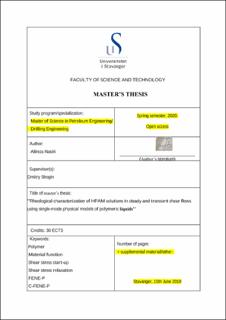| dc.contributor.advisor | Shogin, Dmitry | |
| dc.contributor.author | Nasiri, Alireza | |
| dc.date.accessioned | 2020-10-28T12:32:41Z | |
| dc.date.available | 2020-10-28T12:32:41Z | |
| dc.date.issued | 2020-07 | |
| dc.identifier.uri | https://hdl.handle.net/11250/2685506 | |
| dc.description | Master's thesis in Petroleum engineering | en_US |
| dc.description.abstract | The material function of Partially Hydrolyzed Polyacrylamide (HPAM) in three concentration of Cc=3.104 ppm, Cc=2.104 ppm and Cc=1.5.104 ppm both for steady and transient flow was studied in this research. Then data was fitted to proposed physical in literature such as Modified Finitely Elongated Nonlinear Elastic Dumbbell model (FENE-P),Charged Modified Finitely Elongated Nonlinear Elastic Dumbbell model (C-FENE-P), and different version of Phan-Thien-Tanner model (PTT) to recognize the best representative model for describing material function description of Partially Hydrolyzed Polyacrylamide polymer (HPAM ) both for steady and transient flow. Although the concentration is not focus of this work, it was observed that the slope of power-law region of first normal stress coefficient (Ψ_1) versus applied shear rate (γ ̇) is almost independent of concentration at least for three tested concentration tested in this research (Cc=3.104 ppm , 2.104 ppm ppm,1.5.104 ppm). On the other hand, the slope of power-law region of viscosity (η) versus shear rate (γ ̇) is relatively dependent on concentration again at least for three tested concentration in this research. Moreover, monotonous relation between concentration and material function of both startup and cessation of steady shear flow was observed for these three tested concentrations of HPAM polymer. Finally, the importance of adopting correct approach of data fitting was shown in modeling part of this research, where one should not be relay on slope of exponential decay of cessation of steady shear rate test for modeling part anymore. Furthermore, for almost first time in literature the most recent proposed physical model by Dmitry Shogin and Amundsen (Shogin and Amundsen 2020) called C-FENE-P was evaluated in this research and it was recognized as the best model for describing the material function of both steady and transient flow of HPAM polymer specially regarding more dilute concentrations (Cc=2.104 ppm and Cc=1.5.104 ppm) .Finally, it was observed that both single-mode affine LPPT and single-mode FENE-P model had relatively good performance for describing material function of HPAM polymer for more concentrated sample (Cc=3.104 ppm), though they both relatively failed in prediction of size of overshoot in stress growth of start-up of steady shear rate flow test.
| en_US |
| dc.language.iso | eng | en_US |
| dc.publisher | University of Stavanger, Norway | en_US |
| dc.relation.ispartofseries | Masteroppgave/UIS-TN-IEP/2020; | |
| dc.subject | petroleumsteknologi | en_US |
| dc.subject | boreteknolog | en_US |
| dc.subject | polymer | en_US |
| dc.subject | petroleum engineering | en_US |
| dc.title | "Rheological characterization of HPAM solutions in steady and transient shear flows using single-mode physical models of polymeric liquids’’ | en_US |
| dc.type | Master thesis | en_US |
| dc.subject.nsi | VDP::Teknologi: 500::Berg‑ og petroleumsfag: 510::Petroleumsteknologi: 512 | en_US |
